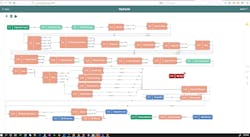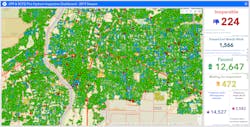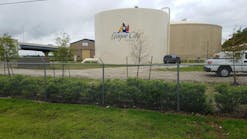Streamlining Hydrant Inspections and Maintenance with ArcGIS and Maximo
The Albuquerque Bernalillo County Water Utility Authority (Water Authority) provides water and wastewater services to the greater Albuquerque metropolitan area. With an annual operating budget of more than $230 million and an annual water production of almost 30 billion gallons (67% surface water, 39% groundwater, 4% reuse), it is the largest water utility in New Mexico. More than 700 employees manage:
• 220,000 customer accounts, representing 6,000+ water users.
• Over 3,000 miles of water supply pipeline.
• Over 2,400 miles of sewer collector pipeline.
• More than $5 billion in assets and $1.2 billion in water rights.
Challenge
Like most water utilities, the Water Authority is required to inspect thousands of fire hydrants (14K+) in a relatively short (4 months) time frame. This process is tedious and mostly manual. Hydrant inspection and maintenance activities are done by Albuquerque Fire and Rescue (AFR) and the Water Authority, respectively. These two large organizations need to communicate inspection results and follow-up work effectively and efficiently since their work is critical to public safety.
Besides helping to ensure public safety, the hydrant inspection process helps to preserve and improve the city's already superior fire insurance rating, which saves taxpayers money. So, moving from a paper process to a more streamlined, electronic inspection tracking system seemed desirable. But that shift also needed to meet several other requirements:
- Remain compatible with and provide access to historic data in its IBM Maximo enterprise asset management (EAM) system.
- Reduce manual errors.
- Simplify the process and reduce user time.
- Provide 100 percent offline maps and inspection input.
- Enable quick retrieval of inspection and work order history in Maximo and ArcGIS® software.
Solution
A longtime ArcGIS user, the Water Authority decided to shift from a paper inspection process to using Collector for ArcGIS as its field inspection solution. Collector provides the necessary offline map and inspection form capabilities, along with the easy manageability required.
AFR and the Water Authority had a fairly extensive list of inspection questions to configure in a web map on the Water Authority's implementation of Portal for ArcGIS, and this web map was deployed to AFR's firefighting teams throughout Albuquerque, with assignments divvied up by fire station.
Closing the loop with EAM (Maximo)
Having the inspection data in ArcGIS was light years ahead of the paper forms. But to make the process more effective, it was important to get the relevant inspection data and (more importantly) the resultant maintenance actions automatically generated and assigned in the Water Authority's EAM system—IBM Maximo. To integrate all this new mountain of inspection data with Maximo, the Water Authority turned to ActiveG, an Esri Silver partner that provides the most advanced ArcGIS integration options for IBM Maximo.
The Water Authority leveraged ActiveG's Nash Workflows application, a no-code web platform for building spatially enabled business process workflows between ArcGIS and Maximo. Nash integrates seamlessly with all Esri® mobile workflows and provides powerful, easy-to-use integration with Maximo business objects.
A Nash workflow was quickly configured to read the ArcGIS inspection data, evaluate the results, and store the relevant inspections as "meter" or conditions in Maximo. This provided a permanent record. The Nash workflow also evaluates inspection results and triggers maintenance work orders, as appropriate. Nash then closes the loop by sending the resultant work order numbers back to ArcGIS so the field users can reference the follow-on work. And lastly, Nash's logic was configured to mark the hydrant features according to their inspection or repair status, based on either ArcGIS or Maximo data. This allows hydrants to be symbolized in near real time, giving maintenance teams and fire crews a bird's-eye view of hydrant system status.
Results
Due to the ease of configuration of both ArcGIS and Nash, the solution was implemented quickly. And once implemented, the benefits were readily apparent:
- High mobile user adoption. The field inspectors/firefighters greatly appreciated the solution. It was easy to use, requiring virtually no training, Maximo knowledge, or back-end process awareness.
- Increased data quality. Fewer errors were introduced due to the elimination of paper processing and the implementation of the easy-to-use Collector form.
- Better visibility and traceability. This process made it easier for maintenance managers to query all the work orders stemming from inspections and identify issues immediately. All the follow-on work orders are automatically spatially rendered for assignment, making progress easy to track.
- Accurate work prioritization. Corrective work orders are now prioritized immediately and accurately, based on inspection results.
- Rapid Deployment. Using Nash for the workflow logic and Collector for ArcGIS for the data collection meant that the business team could configure the solution without a software developer and do it rapidly, in hours, not days. As the team made business process changes, those changes could be reflected in the Nash workflow and tested in minutes, not hours.
- Manageability. Using Nash put all the business logic in one manageable tool, rather than having the logic scattered throughout an enterprise web of apps. And because the workflow logic isn’t scripted, it’s easy for business process owners to configure. Users can copy existing flows and modify them to support other processes. Nash effectively allows the creation of business process templates that can be used over and over, saving dozens of hours of programming time.
The success of the hydrant inspection project has spurred follow-on process improvements for other groups within the Water Authority, including the valve exercising program, which is now adopting a similar process using Collector for ArcGIS and ActiveG Nash, and this team is seeing similarly positive results.
"AFR loves the simplicity of the new mobile inspection web map, and our maintenance planners love the integration with Maximo," said Paul Davidson, IT Manager.






